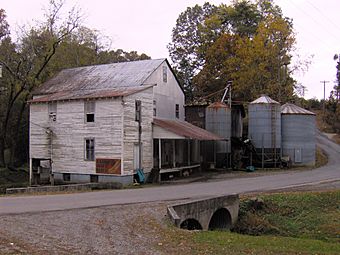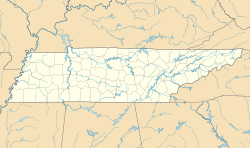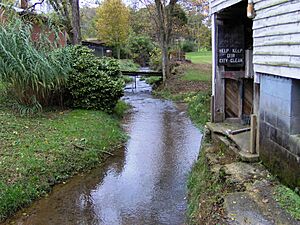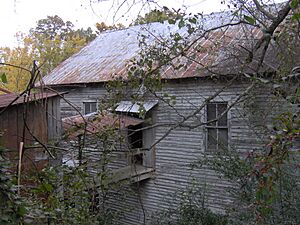Clover Hill Mill facts for kids
Quick facts for kids |
|
|
Clover Hill Mill
|
|

Clover Hill Mill
|
|
| Location | Junction of Mill Road and Clover Hill Road |
|---|---|
| Nearest city | Maryville, Tennessee |
| Area | 1.5 acres (0.61 ha) |
| Built | 1921 |
| MPS | Blount County MPS |
| NRHP reference No. | 89000871 |
| Added to NRHP | July 25, 1989 |
The Clover Hill Mill is a historic gristmill in Maryville, Tennessee. A gristmill is a place where grain, like corn or wheat, is ground into flour. In the early 1900s, there were many mills like this in East Tennessee. Today, Clover Hill Mill is one of the few still working. It is the last full-service mill in Blount County. The mill was added to the National Register of Historic Places in 1989. This means it is an important historical site.
The area around the mill, called Clover Hill, started in the 1820s. A gristmill was built there in 1849. The community grew around this mill. By the 1860s, Clover Hill had its own post office, school, church, and general store. In 1906, a new railroad line was built nearby. This caused the community to move to a new spot, now called Binfield. The first gristmill burned down in 1921. The mill you see today was built in its place that same year.
Contents
Where is the Clover Hill Mill Located?
The Clover Hill Mill is found where Clover Hill Mill Road and Clover Hill Road meet. It's about halfway between U.S. Route 411 to the south and Morganton Road to the north. A small stream once powered the mill. This stream is a headwater of Baker Creek. Baker Creek flows into Tellico Lake near Greenback.
A Look Back: The Mill's History
In 1823, an early settler named Abijah Conger came to what is now Clover Hill. He opened a tavern and a general store. These businesses served travelers going between Maryville and Morganton. Conger also grew a lot of clover. Because of this, he named the post office he started "Clover Hill."
In 1841, another settler, John S. Craig, started a church. This church later became the Clover Hill Presbyterian Church. After the Civil War, a doctor named Samuel Gault set up his practice in Clover Hill. He also worked as the community's postmaster.
Building the First Mill
In 1849, a miller named David McKamey built the first Clover Hill Mill. This mill quickly became a busy place for the community. In 1887, two millers named "Martin" and "West" owned and ran the mill.
In 1906, the L&N Railroad finished building a train line nearby. A store owner from Clover Hill, William Carpenter, moved his store closer to the new railroad. He hoped to create a train stop there. In 1907, Carpenter became the postmaster of this new community, which was named "Binfield." The Clover Hill post office closed in 1915.
The Mill Today
The original Clover Hill Mill burned down in 1921. The owner, Gilbert Blankenship, built the current mill on the same spot. Blankenship's new mill used electricity instead of a traditional overshot water wheel.
Later, brothers Russell and Roy Perkins bought the mill. In 1958, Oscar Whitehead purchased it. Today, Oscar Whitehead's sons own and run the mill. They took over from their father in 1978.
How the Mill is Designed
The Clover Hill Mill is a two-and-a-half-story building. It has a metal, gable roof and weatherboard siding. The building sits on a strong concrete foundation. A porch with square columns stretches across the front.
There are one-story sections on both the east and west sides of the building. These were used for office space and storage. Inside the mill, much of the original machinery is still there.
Other Buildings Around the Mill
Around the main mill building, there are a few other structures. There's a storage shed made of wood, built around 1960. There are also four metal grain silos, built between 1969 and 1975. Because these buildings are newer, they are not considered part of the original historic listing. You can also find the concrete foundation of the first mill's old overshot water wheel behind the current building.





